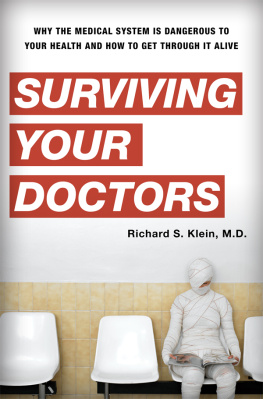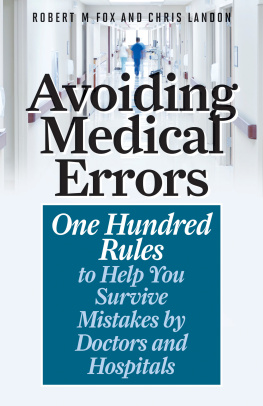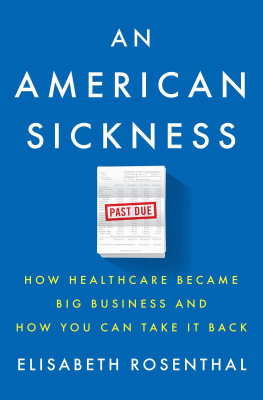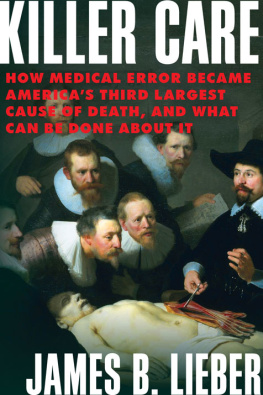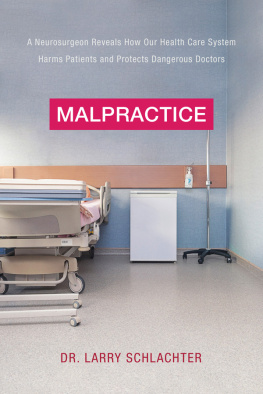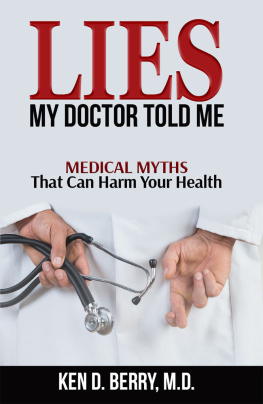Introduction
The malpractice crisis is malpractice (itself).
Vice p resident Albert Gore, May 1993
The problem is not a malpractice insurance crisis. Nor, contrary to popular mythology, is the problem a lawsuit crisis. The real crisis is the degree of malpractice itself.
Business Week , August 3, 1987
E very year at least 100,000 patients die in our American hospitals because of malpractice. You might want to read that statistic again. It is more than the number of soldiers who died in the Korean and Vietnam wars combined.
Every year.
That is like having 300 jumbo jets crash and kill everyone!
Every year!
Or one jumbo jet crashing almost every day !
And that figure doesnt represent those who are hurt or maimed, which is probably two to three times that number. And the price to these individuals, their families, and society at large is approximately $30 billion annually ! The financial and human costs are staggering.
Out of the 800 million passengers who fly every year in the United States, on average 50 to 200 are killed in commercial air crashes. If that figure were artificially raised to 100,000 people killed in crashes, the percentage of mishap would be low, but frightening. In comparison, there are 36 million admissions to the 5,700 hospitals in the United States annually and at least 100,000 people are killed by medical malpractice. Certainly, this is a larger percentage than flying mishaps.
However, if jumbo jets started falling out of the sky like flies dont you think there would be an outcry or maybe an investigation? I think that we can say with certainty that the entire air travel industry would grind to a screeching halt and the whole world would become galvanized around the issue. But how often do you hear stories focusing on this medical crisis? How many politicians are speaking about it in Congress? How often does the president address the fact that more people die every year in medical mistakes than a total of thirty September 11 tragedies combined?
Instead, the news cycles are crammed with the latest celebrity news of who is dating whom and who is having whose baby.
Again, the question arises, where is the outcry about medical injuries and malpractice?
Surviving Your Doctors is that voice.
For too long, wrongful outcomes from substandard or negligent care have been swept under the rug. We hear from physicians complaining about the high cost of medical malpractice insurance. They besiege our political leaders regularly, asking that caps be placed on awards given to injured patients or their surviving family members. High insurance premiums have forced good doctors out of the medical business. Others have stopped performing high-risk procedures. And all of this has left patients with less access to advanced medicine and doctors who are less willing to really engage in an intimate way, the only way that can ultimately lead to better health care in the long run.
Patients need to know what is really going on, and just like walking into a war zone, they need to know how to protect and defend themselves. In this book I provide the in-depth explanations, guidance, and directions that will be the basic training manual we all need to survive and, hopefully, even to thrive. This book will serve as a map of the medical minefield, designed to show you where to step, where to stop, how to walk around the danger, and how to get out alive. Filled with case studies (in all cases names are pseudonyms to protect patient identities), anecdotes, questionnaires, and checklists, this book will walk you through every major area of the medical worldfrom the doctors office, through the pharmacy, to the labs, outpatient procedures, hospital stays, surgery, and the emergency roomgiving you a clearer picture of how things really work, what the workers really think, what is really going on, and how to take back control of your health care destiny once and for all. If you take to heart what is in these pages, I believe it will be an invaluable tool in your wellness kit.
This book may not solve all the sociopolitical issues surrounding this silent pandemic, but it will prepare you to protect yourself against these needless medical mistakes. And maybe, if enough of us begin to speak up, our media and our leaders will begin to wake up to the number three killer in America the medical industry itself .
But the intention, and if I dare say, the mission, of this book is much more. It is nothing less than to immediately start saving tens of thousands of lives a year while laying the foundation for, and sparking a national dialogue about, our healthcare system that will ultimately save millions more lives in the generations to come.
2
Insurance Companies:
Organized Crime or
Just Bad Policies?
Financial ruin from medical bills is almost exclusively an American disease .
Roul Turley
The State of Health Insurance
C ontrary to what many Americans are told, and perhaps believe, we do not have the best health care or health care system in the world. According to the World Health Organization (WHO), our system is rated lower than most European countries, including the former eastern bloc countries of Poland and the Czech Republic. People in those nations all have longer life spans than we do, and their infant and child mortality and morbidity rates are significantly less. Survival rates for breast and colon cancer seem to be better in these thirty-six other countries. It is true that people come from all over the world to obtain our expertise. This does support the argument that some of our institutions offer the best knowledge that money can buy. But this expertise is available in only 5 percent of our nations hospitals. If you do not have the proper insurance or do not live anywhere near a particular medical institution, you may not get the care you need. We have 50 million uninsured citizens who, study after study, get significantly lower standards of health care than the rest of us and who are a prime target of medical malpractice.
Health care insurance companies are in existence to make money. On one hand, you cannot really blame them. They are, after all, for-profit companies that are legally bound to maximize shareholder value. It seems their need for profit is oftentimes in direct conflict with the patients need for adequate and affordable coverage. This is one of the main premises of Michael Moores movie Sicko. In a very real sense, there is a dangerous conflict of interest here. That topic is beyond the scope of this book, however, but it is something you need to understand so that you can go into the insurance game with your eyes wide open. If we cannot solve this inherent conflict, you can at least be better prepared based on real-world knowledge of how the system works.
It seems to many as if insurance companies were in business merely to make a buck. Plain and simple. One way to reduce their liability, and therefore increase their potential profitability, is to cherry pick their future clients. Many applicants for private insurance are either rejected because of some minimal abnormality found while reviewing their medical records or else they have riders placed on them that do not cover preexisting conditions. These riders may be for a period of one to two years. If you have a chronic illness, you may not be eligible for coverage for that illness, or for any complication thereof, forever.
Some companies offer coverage in some geographic areas where there is a paucity of providers. I have cared for patients whose insurance company afforded access to most specialists, but they were literally in far away counties. I would have had to send a patient twenty or thirty miles away to a surgeon or hospital I didnt know.

